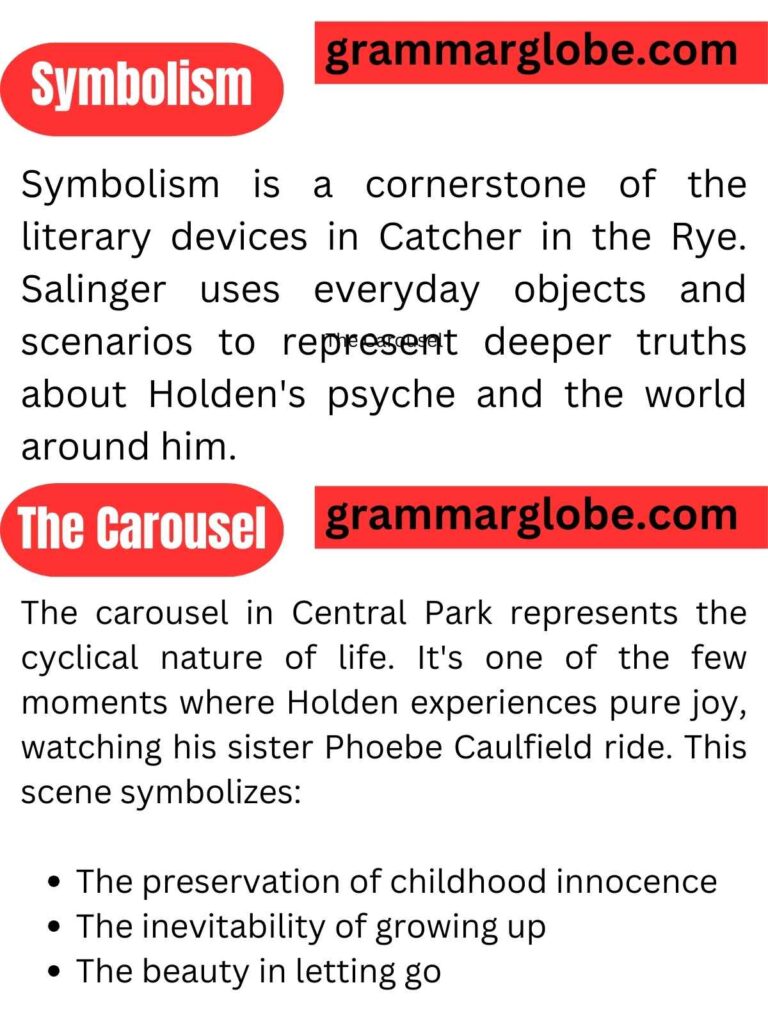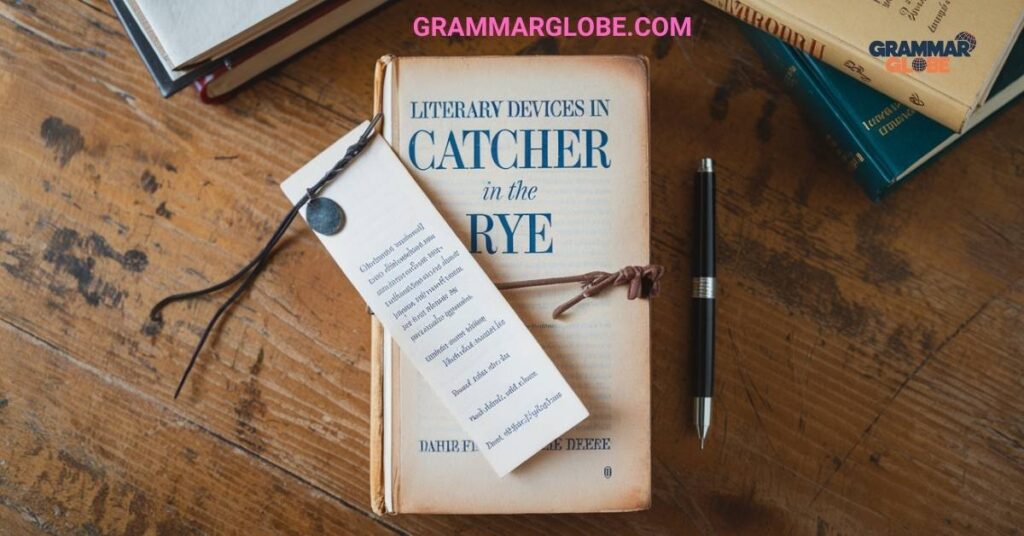Delving into “The Catcher in the Rye” is like opening a time capsule of teenage angst and societal critique. J.D. Salinger’s masterpiece, first published in 1951, continues to captivate readers with its raw portrayal of adolescent struggles and its sharp observations of 1950s America. At the heart of this enduring appeal lies a treasure trove of literary devices that bring Holden Caulfield’s world to vivid life.
From symbolism to stream of consciousness, Salinger weaves a tapestry of narrative techniques that elevate the novel beyond a simple coming-of-age tale. These devices work in concert to create a rich, multi-layered story that resonates across generations. They invite readers to step into Holden’s shoes, experiencing his disillusionment, confusion, and yearning for authenticity firsthand.
In this exploration of literary devices in Catcher in the Rye, we’ll unpack the tools Salinger used to craft his iconic narrative. We’ll examine how these techniques contribute to the novel’s themes, character development, and lasting impact on American literature. Prepare to see this classic work through a new lens, appreciating the artistry behind Holden’s unforgettable voice.
Holden’s World: Setting the Stage
J.D. Salinger’s “The Catcher in the Rye” has captivated readers for generations, its raw portrayal of teenage angst and societal critique leaving an indelible mark on American literature. At the heart of this novel’s enduring appeal lies a masterful use of literary devices that breathe life into Holden Caulfield’s world. Let’s dive deep into the narrative techniques that make this 1950s tale resonate even in today’s digital age.
The year is 1951. America basks in post-war prosperity, yet beneath the surface, societal norms are beginning to shift. It’s against this backdrop that J.D. Salinger introduces us to Holden Caulfield, a 16-year-old boy grappling with the complexities of adolescence and the adult world he’s reluctantly entering.
Salinger’s literary landscape is rich with symbolism, satire, and a unique narrative voice that captures the essence of teenage troubles in the 1950s society. But why does “The Catcher in the Rye” continue to resonate with readers today?
“The mark of the immature man is that he wants to die nobly for a cause, while the mark of the mature man is that he wants to live humbly for one.” – Wilhelm Stekel (quoted in the novel)
This quote, which Holden misattributes to his brother D.B., encapsulates a central theme of the novel: the struggle between idealism and reality. It’s a struggle that transcends generations, making Holden’s journey as relevant now as it was over 70 years ago.
Meet Holden Caulfield: The Voice of a Generation
Holden’s narrative style is the heartbeat of “The Catcher in the Rye.” Salinger’s writing style employs first-person narration, allowing readers to step directly into Holden’s mind. This technique creates an intimacy that’s both uncomfortable and compelling.
The Unreliable Narrator: Truth Through a Teenage Lens
Holden is the quintessential unreliable narrator. His perceptions are colored by his depression, cynicism, and limited life experience. Yet, it’s through this distorted lens that we gain insight into the raw emotions and struggles of adolescence.
Literary Devices in Catcher in the Rye shine through in Holden’s narrative voice:
- Stream of Consciousness: Holden’s thoughts flow freely, often jumping from one topic to another.
- Colloquial Language: The use of slang and informal speech patterns creates authenticity.
- Internal Monologue: We’re privy to Holden’s innermost thoughts, unfiltered and honest.
These devices work in tandem to create a vivid, three-dimensional character whose voice has echoed through the halls of literature for decades.
Symbolism: Unpacking Holden’s Reality
Symbolism is a cornerstone of the literary devices in Catcher in the Rye. Salinger uses everyday objects and scenarios to represent deeper truths about Holden’s psyche and the world around him.
The Red Hunting Hat: Identity and Protection
Holden’s red hunting hat is perhaps the most iconic symbol in the novel. It represents:
- Individuality: Holden wears it when he wants to stand out
- Protection: He dons it in moments of vulnerability
- Connection to childhood: The hat’s unusual appearance links to youthful eccentricity
The Ducks in Central Park: Fears of Change and Growing Up
Holden’s obsession with the ducks in Central Park lagoon symbolizes his fear of change. He wonders:
- Where do they go in winter?
- Who takes care of them?
- Will they return?
These questions mirror Holden’s anxieties about his own future and the loss of innocence.
The Carousel: Cyclical Nature of Life and Innocence
The carousel in Central Park represents the cyclical nature of life. It’s one of the few moments where Holden experiences pure joy, watching his sister Phoebe Caulfield ride. This scene symbolizes:
- The preservation of childhood innocence
- The inevitability of growing up
- The beauty in letting go

Irony and Satire: Holden’s Cynical Worldview
Satire is a powerful tool in Salinger’s arsenal, used to critique the 1950s society through Holden’s cynical observations.
Mocking “Phonies”: Society’s Hypocrisy Through Teenage Eyes
Holden’s constant use of the term “phony” is a satirical jab at what he perceives as adult hypocrisy. He applies this label liberally:
- To his schoolmates at Pencey Prep
- To actors and entertainers
- Even to himself at times
This repetition serves as a motif, highlighting Holden’s disillusionment with the adult world.
The Irony of Holden’s Own Behavior
While Holden criticizes others for being “phony,” he often engages in deceptive behavior himself:
- Lying about his age
- Pretending to be someone he’s not
- Avoiding genuine connections with others
This irony underscores the complexity of Holden’s character and the struggles of adolescence.
Motifs: Threads Weaving the Story Together
Motifs are recurring elements that support the novel’s themes. In “The Catcher in the Rye,” several motifs stand out:
- Loneliness and Isolation
- Holden’s frequent phone calls to people who aren’t available
- His wanderings through New York City
- The Preservation of Innocence
- Holden’s desire to be the “catcher in the rye”
- His protective attitude towards children
- Mental Health and Trauma
- References to Holden’s previous breakdown
- His inability to process his brother Allie’s death
These motifs intertwine, creating a rich tapestry that explores the complexities of teenage life and the human condition.

Figurative Language: Painting Holden’s World
Salinger’s use of figurative language brings Holden’s world to vivid life. Let’s explore some key literary devices in Catcher in the Rye:
Similes: Comparing the Unfamiliar to the Familiar
Holden often uses similes to describe his experiences:
- “I felt like I was sort of disappearing. It was that kind of a baffling afternoon, terrifically cold, and no sun out or anything, and you felt like you were disappearing every time you crossed a road.”
This simile conveys Holden’s sense of alienation and disconnection from the world around him.
Metaphors: Deeper Meanings in Everyday Objects
Metaphors in the novel often carry significant weight:
- The “catcher in the rye” itself is a metaphor for Holden’s desire to protect childhood innocence.
Hyperbole: Holden’s Exaggerated Perceptions
Holden frequently exaggerates, reflecting his emotional state:
- “I have to have this operation. It isn’t very serious. I have this tiny little tumor on the brain.”
This hyperbole reveals Holden’s tendency to dramatize situations, possibly as a cry for attention or understanding.
The Power of Questions: Rhetorical Devices
Rhetorical questions play a crucial role in Holden’s narrative, serving multiple purposes:
- Internal Dialogues
- “Who wants flowers when you’re dead? Nobody.”
- Engaging the Reader
- “You know those ducks in that lagoon right near Central Park South? That little lake? By any chance, do you happen to know where they go, the ducks, when it gets all frozen over?”
- Character Development
- These questions reveal Holden’s curiosity, confusion, and desire for connection.
Language as Identity: Slang and Dialect
Salinger’s use of slang and dialect is a defining feature of the novel. It serves to:
- Authenticate Holden’s voice as a 1950s teenager
- Distinguish Holden from the adult world he critiques
- Create a sense of intimacy with the reader
Some examples of Holden’s distinctive vocabulary:
| Holden’s Slang | Meaning |
|---|---|
| Phony | Fake or insincere |
| Crumby | Disappointing or inadequate |
| Lousy | Bad or poor quality |
| Old | A term of endearment |
This use of language is a key literary device in Catcher in the Rye, contributing to its enduring appeal and authenticity.
Stream of Consciousness: A Mind Laid Bare
Stream of consciousness is perhaps one of the most powerful literary devices in Catcher in the Rye. This technique allows readers to experience Holden’s thoughts as they occur, unfiltered and raw.
Blurring Past and Present
Holden’s narrative often jumps between past and present, mirroring the way our minds naturally wander:
“I remember this one afternoon, in this place where we were supposed to have a tennis match with Tudor School or something, but nobody played flute in the band, so we didn’t go.”
This seemingly random memory illustrates how Holden’s mind works, connecting disparate events and thoughts.
Revealing Holden’s Thought Processes
Stream of consciousness reveals Holden’s internal contradictions and struggles:
“I felt so lonesome, all of a sudden. I almost wished I was dead.”
These sudden mood swings and extreme thoughts provide insight into Holden’s fragile mental state.
Allusions: Connecting to a Broader Context
Salinger peppers the novel with allusions to literature, history, and popular culture. These references serve to:
- Establish Holden’s intelligence and well-read nature
- Connect the story to broader themes in literature and society
- Provide commentary on the cultural landscape of the 1950s
Some notable allusions include:
- Romeo and Juliet: Holden’s thoughts on Romeo reflect his own romantic ideals
- The Great Gatsby: Subtle parallels can be drawn between Holden and Gatsby’s character
- David Copperfield: Holden’s narrative style echoes Dickens’ first-person approach
Foreshadowing and Flashbacks: Time as a Literary Device
Salinger masterfully manipulates time in “The Catcher in the Rye,” using foreshadowing and flashbacks to create tension and depth.
Hints of Holden’s Breakdown
Throughout the novel, there are subtle hints that Holden is headed for a breakdown:
- His frequent mentions of feeling “depressed”
- References to his previous hospitalization
- His increasingly erratic behavior
Memories of Allie: The Impact of Loss
Flashbacks to Holden’s deceased brother Allie provide crucial context for understanding Holden’s emotional state:
“I slept in the garage the night he died, and I broke all the goddam windows with my fist, just for the hell of it.”
These memories reveal the depth of Holden’s unresolved grief and its impact on his current behavior.
The Impact of Literary Devices in “The Catcher in the Rye”
The literary devices in Catcher in the Rye work in concert to create a novel that’s greater than the sum of its parts. They contribute to:
- The novel’s enduring appeal across generations
- Its influence on modern literature and popular culture
- Its ability to spark discussions about mental health, societal norms, and the challenges of growing up
Why Studying These Devices Matters
For readers and writers alike, understanding the literary devices in Catcher in the Rye offers valuable insights:
- It enhances appreciation of the novel’s craftsmanship
- It provides tools for analyzing other works of literature
- It inspires new approaches to storytelling and character development
Beyond the Page: “The Catcher in the Rye” in Popular Culture
The influence of “The Catcher in the Rye” extends far beyond the realm of literature. Its impact can be seen in:
- Films that explore teenage alienation
- Music lyrics that echo Holden’s cynicism and vulnerability
- Television shows that reference the novel or its themes
The book’s controversial history, including its frequent banning in schools, has only added to its mystique and cultural significance.
Conclusion: The Enduring Legacy of Holden Caulfield
“The Catcher in the Rye” continues to resonate with readers in the 21st century, its themes of alienation, loss of innocence, and the struggle to find one’s place in the world as relevant now as they were in the 1950s.
The literary devices in Catcher in the Rye – from its unique narrative voice to its rich symbolism – create a novel that’s both a time capsule of mid-20th century America and a timeless exploration of the human condition.
As we continue to grapple with issues of mental health, societal pressures, and the challenges of growing up, Holden Caulfield’s voice remains a poignant reminder of the complexities of the teenage experience. Through Salinger’s masterful use of literary techniques, we’re invited not just to read Holden’s story, but to live it, to feel it, and perhaps, to understand ourselves a little better in the process.

Oliver Smith is an experienced blogger at Grammar Globe, Oliver Smith, an expert in English grammar and a master of wit, brings language to life with his playful take on puns. Through his works, he weaves humor into the rules of grammar, making learning fun and engaging for readers of all ages. Discover language with a smile!”






